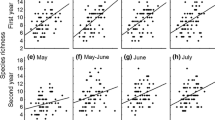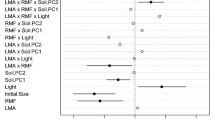Abstract
Several theoretical considerations imply that high shoot morphological plasticity could increase competition symmetry and favour plant coexistence. We tested whether mean plasticity across co-occurring species is a key trait for explaining ramet density and species richness in herbaceous vegetation. We used three data sets to test the hypotheses: (a) experimentally achieved estimates of plasticity to light availability for 35 herbaceous species; (b) richness, ramet density and canopy architecture data from 17 herbaceous communities; (c) species richness data from a 5-year permanent-plot study in a calcareous grassland. In herbaceous communities containing species with relatively higher shoot plasticity, ramet density was significantly higher. Consequently, relatively more species were growing per unit area—a greater proportion of the community species pool was represented on 1 m2. In the permanent plot study species-richness was higher in those 40×40 cm quadrats where species with high shoot plasticity prevailed—there was a positive regression of richness on the mean plasticity of species. This relationship was highly significant in five consecutive years. Our results suggest that shoot plasticity to light availability is evidently one of the key traits in processes that alter the density of co-existing plants and, therefore, species diversity in herbaceous communities.



Similar content being viewed by others
References
Agrawal AA (2001) Phenotypic plasticity in the interactions and evolution of species. Science 1:321–326
Alpert P, Simmis EL (2002) The relative advantages of plasticity and fixity in different environments: when is it good for a plant to adjust? Evol Ecol 16:285–297
Ballaré CL (1999) Keeping up with the neighbours: phytochrome sensing and other signalling mechanisms. Trends Plant Sci 4:97–102
Ballaré CL, Scopel AL (1997) Phytochrome signaling in plant canopies. Testing its population-level consequences using photoreceptor mutants of Arabidopsis. Funct Ecol 11:441–450
Ballaré CL, Scopel AL, Jordan ET, Viestra RD (1994) Signalling among neighboring plants and the development of size inequalities in plant populations. Proc Natl Acad Sci Biol 91:10094–10098
Berntson GM, Wayne PM (2000) Characterizing the size dependence of resource acquisition within crowded plant populations. Ecology 81:1072–1085
Booth RE, Grime JP (2003) Effects of genetic impoverishment of plant community diversity. J Ecol 91:721–730
Caldeira M, Fyel RJ, Lawton JH, Pereira JS (2001) Mechanisms of positive biodiversity–production relationships: insights provided by δ13C analysis in experimental Mediterranean grassland plots. Ecol Lett 4:439–443
Calhill JF (2003) Lack of relationship between below-ground competition and allocation to roots in 10 grassland species. J Ecol 91:532–540
Callaway RM, Pennings SC, Richards CL (2003) Phenotypic plasticity and interactions among plants. Ecology 84:1115–1128
Carson WP, Pickett STA (1990) Role of resources and disturbance in the organization of an old-field plant community. Ecology 71:226–238
Casal JJ, Mazzella MA (1998) Conditional synergism between cryptochrome 1 and phytochrome B is shown by the analysis of phyA, phyB, and hy4 simple, double, and triple mutants in Arabidopsis. Plant Physiol 118:19–25
Casper BB, Cahill JF, Hyatt LA (1998) Above-ground competition does not alter biomass allocated to roots in Abutilon theophrasti. New Phytol 140:231–238
Cheplick GP (2003) Evolutionary significance of genotypic variation in developmental reaction norms for a perennial grass under competitive stress. Evol Ecol 17:175–196
Cody ML (1991) Niche theory and plant growth form. Vegetatio 97:39–55
Coleman JS, McConnaughay KDM (1995) A non-functional interpretation of a classical optimal-partitioning example. Funct Ecol 9:951–954
Day KJ, Hutchings MJ, John EA (2003) The effects of spatial pattern of nutrient supply on yield, structure and mortality in plant populations. J Ecol 91:541–553
Dononhue K, Schmitt J (1999) The genetic architecture of plasticity to density in Impatiens capensis. Evolution 53:1377–1386
Dononhue K, Pyle EH, Messiqua D, Heschel MS, Schmitt J (2001) Adaptive divergence in plasticity in natural populations of Impatiens capensis and its consequences for performance in novel habitats. Evolution 55:692–702
Dorn LA, Pyle EH, Schmitt J (2000) Plasticity to light cues and resources in Arabidopsis thaliana: testing for adaptive value and costs. Evolution 54:1982–1994
Eek L, Zobel K (1997) Effects of additional illumination and fertilization on seasonal changes in fine-scale grassland community structure. J Veg Sci 8:225–234
Eek L, Zobel K (2001) Structure and diversity of a species-rich grassland community, treated with additional illumination, fertilization and mowing. Ecography 24:157–164
Ellenberg H, Weber HE, Düll R, Wirth V, Werner W, Paulisen D (1991) Zeigerwerte von Pflanzen in Mitteleuropa. Scripta Geobot 18:1–248
Falster DS, Westoby M (2003) Plant height and evolutionary games. Trends Ecol Evol 18:337–343
Garcia-Berthou E (2001) On the misuse of residuals in ecology: testing regression residuals vs. the analysis of covariance. J Anim Ecol 70:708–711
Gavrilets S, Scheiner SM (1993) The genetics of phenotypic plasticity. V. Evolution of reaction norm shape. J Evol Biol 6:31–48
Gehring CA (2003) Growth responses to arbuscular mycorrhizae by rain forest seedlings vary with light intensity and tree species. Plant Ecol 167:127–139
Genoud T, Métraux J (1999) Crosstalk in plant cell signalling: structure and function of the genetic network. Trends Plant Sci 4:503–507
Gersani M, Abramsky Z, Falik O (1998) Density-dependent habitat selection in plants. Evol Ecol 12:223–234
Goldberg DE, Estabrook GF (1998) Separating the effects of number of individuals sampled and competition on species diversity: an experimental and analytic approach. J Ecol 86:983–988
Goldberg DE, Miller TE (1990) Effects of different resource additions on species diversity in an annual plant community. Ecology 71:213–225
Grime JP (1979) Plant strategies and vegetation processes, 1st edn. Wiley, New York
Jolicoeur P (1989) A simplified model for bivariate complex allometry. J Theor Biol 140:41–49
van Kleunen M, Fischer M (2001) Adaptive evolution of plastic foraging responses in a clonal plant. Ecology 82:3309–3319
Kull K, Zobel M (1991) High species richness in an Estonian wooded meadow. J Veg Sci 2:711–714
Leht M (1999) Eesti taimede määraja, 1st edn. Eesti Loodusfoto, Tartu
Liira J, Zobel K (2000a) The species richness–biomass relationship in herbaceous plant communities: what difference does the incorporation of root biomass data make? Oikos 91:109–114
Liira J, Zobel K (2000b) Vertical structure of a species-rich grassland canopy, treated with additional illumination, fertilization and mowing. Plant Ecol 146:185–195
McConnaughay KDM, Coleman JS (1999) Biomass allocation in plants: ontogeny or optimality? A test along three resource gradients. Ecology 80:2581–2593
Mclellan AJ, Law R, Fitter AH (1997) Response of calcareous grassland plant species to diffuse competition: results from a removal experiment. J Ecol 85:479–490
Neff MM, Chory J (1998) Genetic interactions between phytochrome A, phytochrome B, and Cryptochrome 1 during Arabidopsis development. Plant Physiol 118:27–36
Pigliucci M, Schmitt J (1999) Genes affecting phenotypic plasticity in Arabidopsis: pleiotropic effects and reproductive fitness of photomorphogenic mutants. J Evol Biol 12:551–562
Rajaniemi TK (2003) Explaining productivity–diversity relationships in plants. Oikos 101:449–457
Rajaniemi TK, Allison VJ, Goldberg DE (2003) Root competition can cause a decline in diversity with increased productivity. J Ecol 91:407–416
Scheiner SM (1993) Genetics and evolution of phenotypic plasticity. Annu Rev Ecol Syst 24:35–68
Schlichting CD, Pigliucci M (1998) Phenotypic evolution. A reaction norm perspective, 1st edn. Sinauer Associates, Sunderland
Schlichting CD, Smith H (2002) Phenotypic plasticity: linking molecular mechanisms with evolutionary outcomes. Evol Ecol 16:189–211
Schmitt J, Wulff RD (1993) Light spectral quality, phytochrome and plant competition. Trends Ecol Evol 8:47–51
Schmitt J, Dudley SA, Pigliucci M (1999) Manipulative approaches to testing adaptive plasticity: phytochrome-mediated shade-avoidance responses in plants. Am Nat 154:S43–S54
Schwinning S, Weiner J (1998) Mechanisms determing the degree of size asymmetry in competition among plants. Oecologia 113:445–447
Sekimura T, Roose T, Li B, Maini PK, Suzuki J, Hara T (2000) The effect of population density on shoot morphology of herbs in relation to light capture by leaves. Ecol Model 128:51–62
Sokal RR, Rolf FJ (1995) Biometry: the principles and practice of statistics in biological research, 3rd edn. W. H. Freeman, New York
Sorrensen-Cothern KA, Ford ED, Sprugel DG (1993) A model of competition incorporating plasticity through modular foliage and crown development. Ecol Monogr 63:277–304
Stoll P, Weiner J, Muller-Landau H, Müller E, Hara T (2002) Size symmetry of competition alters biomass–density relationship. Proc R Soc Lond B 269:2191–2195
Stratton D (1998) A reaction norm functions and QTL-environment interactions for flowering time in Arabidopsis thaliana. Heredity 81:144–155
Stuefer JF, Huber H (1998) Differential effects of light quantity and spectral light quality on growth, morphology and development of two stoloniferous Potentilla species. Oecologia 117:1–8
Sultan SE (1995) Phenotypic plasticity and plant adaptation. Acta Bot Neerl 44:363–383
Weiner J (1990) Asymmetric competition in plant populations. Trends Ecol Evol 5:360–364
Weiner J, Berntson BM, Thomas SC (1990) Competition and growth form in a woodland annual. J Ecol 78:459–469
Weinig C (2000) Plasticity versus canalization: population differences in the timing of shade-avoidance responses. Evolution 54:441–451
Westoby M (2002) Choosing species to study. Trends Ecol Evol 17:587
Wilson JB, Steel JS, Newman JE, King WM (2000) Quantitative aspects of community structure examined in semi-arid grassland. J Ecol 88:749–756
Zobel K (2001) On the species-pool hypothesis and on the quasi-neutral concept of plant community diversity. Folia Geobot 36:3–8
Zobel K, Liira J (1997) A scale-independent approach to the richness vs. biomass relationship in ground-layer plant communities. Oikos 80:325–332
Acknowledgements
We are grateful to Jacob Weiner for useful discussion. Many thanks to Tõnu Möls and members of the working group who helped with the experiments. The work was supported by ESF (5535) and Tartu University (2540). The experiments comply with the current laws of the Republic of Estonia.
Author information
Authors and Affiliations
Corresponding author
Additional information
Communicated by Christian Koerner
Electronic supplementary material
Rights and permissions
About this article
Cite this article
Lepik, M., Liira, J. & Zobel, K. High shoot plasticity favours plant coexistence in herbaceous vegetation. Oecologia 145, 465–474 (2005). https://doi.org/10.1007/s00442-005-0142-0
Received:
Accepted:
Published:
Issue Date:
DOI: https://doi.org/10.1007/s00442-005-0142-0




